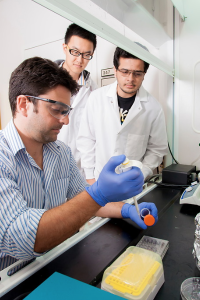Document Type
Article
Publication Title
Theranostics
Abstract
Means to overcome tumor hypoxia have been the subject of clinical investigations since the 1960’s; however these studies have yet to find a treatment which is widely accepted. It has been known for nearly a century that hypoxic cells are more resistant to radiotherapy than aerobic cells, and tumor hypoxia is a major factor leading to the resistance of tumors to radiation treatment as well as several cytotoxic agents. In this manuscript, the application of ultrasound combined with oxygen-carrier microbubbles is demonstrated as a method to locally increase dissolved oxygen. Microbubbles can also be imaged by ultrasound, thus providing the opportunity for image-guided oxygen delivery. Simulations of gas diffusion and microbubble gas exchange show that small amounts (down to 5 vol%) of a low-solubility osmotic gas can substantially increase microbubble persistence and therefore production rates and stability of oxygen-carrier microbubbles. Simulations also indicate that the lipid shell can be engineered with long-chain lipids to increase oxygen payload during in vivo transit. Experimental results demonstrate that the application of ultrasound to destroy the microbubbles significantly enhances the local oxygen release. We propose this technology as an application for ultrasound image-guided release of oxygen directly to hypoxic tissue, such as tumor sites to enhance radiotherapy.
First Page
1174
Last Page
1184
DOI
10.7150/thno.4410
Publication Date
12-23-2012
Recommended Citation
Kwan, J. J., Kaya, M., Borden, M. A., & Dayton, P. A. (2012). Theranostic oxygen delivery using ultrasound and microbubbles. Theranostics, 2(12), 1174-1184.
duplicate of article


